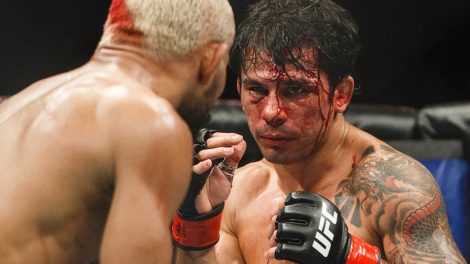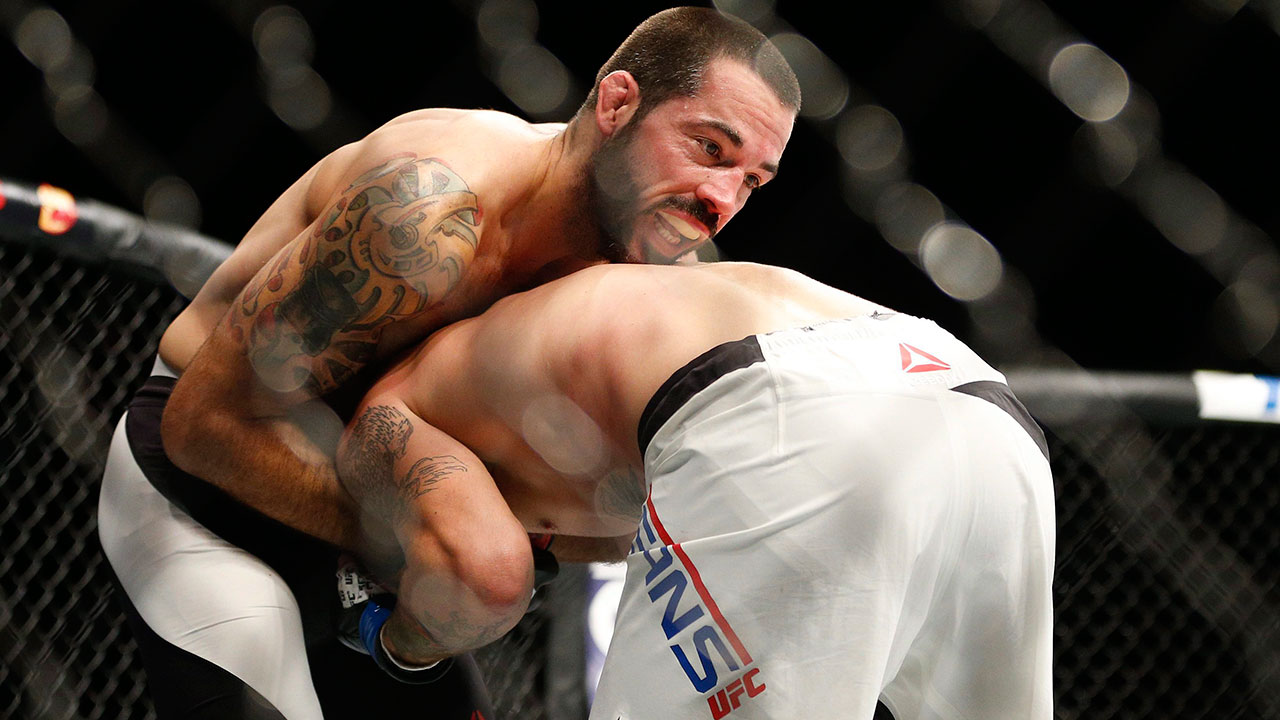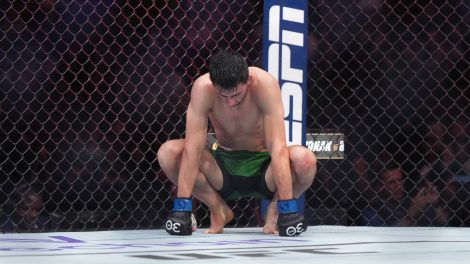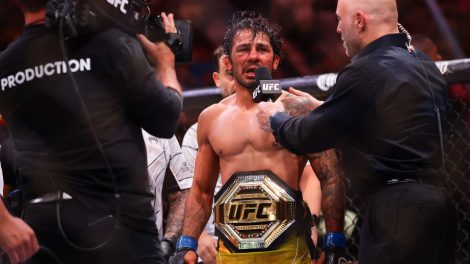TORONTO — Sean Strickland rarely presented as someone who was particularly comfortable with being a UFC titleholder, and one reading of the now former middleweight champion’s recent behaviour — uttering death threats, brawling in the stands at a UFC event, using media availabilities to broadcast an utterly poisoned worldview — is self-sabotage.
It’s a theory. If he did truly value the position, it’s hard to fathom a rational actor taking some of the risks Strickland steered headfirst into since he won the belt from Israel Adesanya in one of the biggest upsets in UFC history. Of course, juxtaposing the words “rational” and “Strickland” may be a fraught premise to begin with.
Either way, Strickland’s brief title reign is over now, after he dropped a split decision (47-48, 48-47, 48-47) Saturday night to the indefatigable Dricus Du Plessis. And thus ends a strange four months for Strickland, for UFC, and for its middleweight division.
“I honestly thought I did enough — I thought I had it. And then when that split decision came, I just went, ‘OK, this is 100 per cent 50-50,’” Du Plessis said. “And then when they said, ‘And New,’ it felt like 15 years of work and dreaming and sacrificing of everything came together in one single sentence. It’s incredible. It feels surreal. It’s amazing.”
Credit Du Plessis, who no one would describe as technically proficient but raised his game in notable, important ways at Scotiabank Arena to topple Strickland, extend a seven-fight win streak to begin his UFC career, and become the promotion’s first South African champion.
Back when Du Plessis was first making his way up UFC’s middleweight ranks, you never would’ve seen this day coming. His stand-up was awkward and clunky. He tired quickly, breathing noticeably through his mouth. Visibly larger than everyone he shared an octagon with, he won fights by sheer force of nature, bull-rushing takedowns and physically overwhelming his opponents. But it didn’t look like an approach that would continue to work at higher levels against more skillful opponents.
But then Du Plessis had his septum repaired, which super-charged his cardio and elevated his game. Against Robert Whittaker last July — Du Plessis’ first fight following the nose surgery — he was switching stances, landing cleanly to the legs and body, and bullying his way to a takedown against a former champion with some of the best takedown defence in the division. And against Strickland Saturday, he was managing his gas tank, making defensive adjustments, and putting one of the sport’s most persistent pressure fighters on the backfoot.
“It’s a lot easier said than done to keep him on the backfoot,” Du Plessis said. “He doesn’t storm forward, but he has a strong march. The way he moves, it makes it hard to push him backwards. But I just kept on putting the pressure on. Every time he jabbed — moving forward, moving forward.”
Strickland will always be a weird look, fighting from behind a Philly shell, square to his opponent, stiff-as-a-board upright. But his game contains several X-factors that helped him reach this unlikely point in his career. In his jab, he has a dependable weapon to construct his gameplans around. In Eric Nicksick, he has one of the top coaches in the game. In his gas tank, he has a reservoir of energy we haven’t yet seen the bottom of.
And the jab was there for Strickland early against Du Plessis, as he landed it repeatedly right down the pipe. Content to wear them while working an uncharacteristically conservative strategy, Du Plessis countered with low kicks and shot for a double-leg late in the first round that he completed but couldn’t do much with. Strickland was quickly back up to his feet and easily took a lead.
In the second, Du Plessis threw more often, attempting a pair of spinning back fists and some large, looping overhand rights. Again, he shot late and brought Strickland to the mat but couldn’t hold him there. But the best thing Du Plessis did was make an adjustment to evade Strickland’s persistent jabs and teeps. He hardly wore anything all round and evened the score.
“Listen, he is good. He’s definitely good,” Du Plessis said. “He caught me in the first round with the jab. And then I realized, I can’t let him get away with that.”
Du Plessis built from there, firing far more aggressively early in the third with huge overhands and heavy leg kicks. Strickland on the backfoot was a strange sight to see, but such was the persistence and effectiveness of Du Plessis’ attack. Forced from his pressure game, Strickland generated little offence and dropped a second straight round on two of three cards.
“First two rounds, our plan was 100 per cent to fight his fight. Not to go out and fight the way that I fight,” Du Plessis continued. “He jabs, I jab. One-two’s, nothing too serious. And then from round number three, we start turning it up.”
Strickland tried to work his way back into some go-forward in the fourth, jabbing as he had in the first, but Du Plessis kept him in constant danger with his trademark counter blitzes. Nothing was pretty; nothing was efficient. But you have to respect a haymaker no matter how telegraphed. And Du Plessis kept finding the energy to wing them. Mix in a series of takedowns towards the end, and Du Plessis went into the fifth with momentum and another round in his favour.
A cut around his left eye grew progressively worse with time, Strickland needed to find a moment in the fifth and went for it in flurries. But Du Plessis was sitting back on defence, absorbing Strickland’s increased output while layering in the odd single shot of his own. Du Plessis finally appeared to tire, and Strickland pressed straight to the finish, head-hunting with abandon. It was the epitome of a championship fifth round. And all three judges awarded it to Strickland.
A give-or-take fight; you could’ve made a legitimate case either way. But Du Plessis’ power ultimately showed better than Strickland’s volume. Two of the three judges saw it Du Plessis’ way despite Strickland quantitatively landing more often in four of five rounds and finishing with 36 more significant strikes. And appearances matter. Strickland couldn’t find forward pressure from the second round on and even showed signs of fatigue at times — two things we haven’t been able to say about him in any fight prior.
“At the end of the day, I went toe-to-toe with the self-proclaimed — and some people think — best boxer in the UFC,” Du Plessis said. “Yeah, I took a couple of punches. More than I would’ve liked. But every time he hits, I move in, I move forward. Even him being the cardio machine that he is, by the third round you can’t keep on fighting with that kind of pressure. He got tired. And that’s where I really started landing more and more.”
In a lot of ways, it was a typical Du Plessis fight. He does get hit. But Du Plessis has proven strong enough to withstand that punishment. And one of his best tactics is how quickly and gamely he responds and blitzes after he’s defended an attack. Every strike his opponent throws at him is answered with one, two, three of his own. How overwhelming Du Plessis can be when he swarms was never in question. But whether he could sustain the energy needed to mount those offensives in the later rounds of championship fights was.
Those questions answered, Du Plessis walked from the octagon Saturday with a title around his waist. What distinguishes him, even at the highest level of professional fighting, is sheer, indefatigable will. Few pursue their fights as relentlessly. And although it’ll look awkward at times — entering the fight, Strickland described Du Plessis’ game as “weird” and difficult to prepare for — the South African’s athleticism helps him overcome whatever technical disadvantages he finds himself up against.
“Nothing’s changed. I’ve just gotten my octagon time. And settled, settled. Found a home in the UFC. That’s what I needed,” Du Plessis said. “We had some problems in terms of the conditioning that we’ve fixed. I feel incredible. I think it’s just about finding your feet in that octagon and accepting and believing that you’re one of the best in the world.”
Meanwhile, there’s no such thing as an accidental UFC champion — but Strickland was as close as it gets. Only a year ago he was charting a Donald Cerrone arc, a company man headlining Fight Nights against middling middleweights before a few dozen spectators at UFC Apex. After he dropped a split decision to Jared Cannonier at UFC’s final card of 2022, he spun right around less than a month later to fight up a division at its first of 2023, stepping in on short notice for an injured Kelvin Gastelum, a company man doing his part to help salvage an event.
Remember, that’s how he got his title shot, too. Adesanya was meant to fight Du Plessis in a grudge match at UFC 293, but the South African was unavailable due to injury. The New Zealand-based Adesanya wanted to stay on the Australia-hosted card and Strickland was handpicked to fly across the globe as a glorified tune-up. No oddsmaker, analyst, or fan gave Strickland a prayer. He’d already flopped twice in opportunities against up-division competition, getting flattened by Alex Pereira prior to the Cannonier defeat. What on this green earth was he going to have for a striker as proficient as Adesanya?
No one thought any of this was possible until Strickland turned up in Sydney, fighting behind his Philly shell, pressuring, jabbing, and dropping Adesanya with a shocking one-two at the end of the first round. He just about emptied the tank trying to finish it right then and there. And when Adesanya survived to hear the horn, Strickland gave him a wink and a nod.
At the end of five rounds, he’d crafted a sport-shocking performance. A literally life-changing effort that subverted an entire division. It says something about how convincingly Strickland seized the belt that no one even considered Adesanya, who’d competed in each of the last nine middleweight title fights and won seven of them, for an immediate rematch. The image of Strickland taunting Adesanya as he walked him down at the end of the fifth round was too hard to shake.
What a sport. Whether UFC liked it or not, Strickland’s Apex residency would have to be put on hold. Whether Strickland liked it or not, too. He spent the ensuing four months seemingly doing everything in his power to imperil himself and see how far he could push the boundaries within which UFC would let him continue as champion.
To be fair, Strickland did do the heavy lifting in promoting his one and only title defence. But also to be fair, Du Plessis didn’t have much of a choice. A plucky South African kickboxer’s pursuit of self-betterment just doesn’t quite drive site traffic the same way as a walking, talking 17-car pileup like Strickland. And the unlikely champion was all too willing to oblige the chaos and recklessness with which fans had come to expect everywhere he went.
Still, it feels at times like there is some method to his madness — that everything about his just-a-red-blooded-American-calling-it-as-he-sees-it persona, from the plain white t-shirts with jeans to the constant boundary-pushing, seems a little too on the nose. Maybe that’s just who he really is. Or maybe it’s an exaggerated representation of who he really is. It’s just hard to imagine someone who lives that life 24/7 somehow becoming a UFC champion.
Which was perhaps the conflict for Strickland himself. Just as we never foresaw him here, having a gold belt wrapped around his waist, he probably never foresaw it himself. And confronted with the reality, and all the demands of one’s time and energy that comes with it, he retreated to the only way he knew how to be. Brash. Ungovernable. Self-sabotaging. It’s one thing when you’re headlining three Fight Nights a year. It’s another when you’re a champion atop pay-per-views.
However Strickland’s reign will be remembered, it’s over now. And it’s difficult to imagine UFC ever letting him get close to a title shot again. What’s next for Du Plessis? Finally settling the grudge match with Adesanya makes a great deal of sense. Could Du Plessis turn around in time for that fight to feature at UFC 300 on April 13? Would Adesanya, possibly injured and definitely evasive as to his intentions since the loss to Strickland, be ready for that?
“I’m pretty banged up right now,” Du Plessis said, his left eye nearly swollen shut. “But UFC 300 sounds amazing.”
Or is it another direction entirely? Despite speculation as to whether he can currently enter and work in the US, Khamzat Chimaev has been dropping conspicuous social media hints recently that he’s eyeing a UFC 300 appearance.
Chimaev’s once-soaring stock has been tumbling back to earth since a barn-burning stretch to begin his UFC career; and his lone fight in 2023 was a majority decision over Kamaru Usman that arguably registered as a pyrrhic victory. But the promotion has seemed determined to get him into a title fight one way or another for some time now; if it had its druthers, it likely would’ve booked him for Strickland’s first defence rather than DuPlessis.
Meritocratic or not, there’s no denying Chimaev’s name recognition and the magnetism his booking would bring to a card as important as 300. It would certainly generate a tad more buzz than Belal Muhammad vs. Leon Edwards.
Of course, there’s also a Whittaker vs. Paulo Costa booking next month that could be influential. A Whitaker rematch so soon after Du Plessis ran through him in July may not make sense, but what if Costa has a standout performance that night? The 32-year-old fell flat the last time he fought for a title against Adesanya in 2020, but recency bias is a hell of a drug. It’s at least a fresh matchup, as would be Cannonier who’s coming off a pair of victories and currently unbooked.
But perhaps the simplest solution is booking Edwards and Muhammad for 300, letting Du Plessis heal up following a brutal five-round effort, and then taking him and Adesanya to South Africa later this year. That’s the location UFC President Dana White suggested the promotion could look at now that it has a South African champion. And, unlike the man he defeated Saturday, no one’s going to have to worry about Du Plessis staying out of trouble long enough to get there.
“I think it’s time. I think we’ve worked our asses off to get this event to Africa and South Africa. And it’s time that happens,” Du Plessis said. “There’s one thing about South Africa that I think, if the UFC goes there, the whole world is going to see — you have never felt a vibe, when it comes to sport, like South Arica.”









